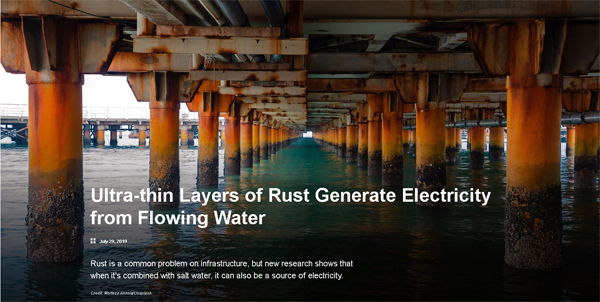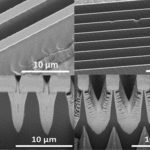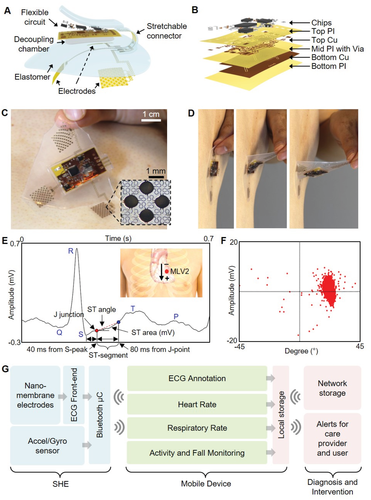(Ultra-thin Layers of Rust Generate Electricity from Flowing Water)
2019/7/29 アメリカ合衆国・カリフォルニア工科大学 (Caltech)

・ Caltech とノースウェスタン大学の科学者たちが、錆である酸化鉄の薄膜に塩水をかけて発電する技術を開発。持続可能な発電の新しい手法になりうると期待される。
・ 金属化合物と塩水の相互作用は電気を発生するが、通常はバッテリー内で 1 個以上の化合物が新しい化合物に変換される際におきる化学反応の結果である。
・ これとは対照的な新技術は、化学反応には頼らず、流れる塩水の運動エネルギーを電気に変換。この現象は、六方格子に配列された炭素原子のグラフェンシートの薄膜でもすでに観測されており、運動エネルギーを電力に変換する効率は約 30%であった。太陽光発電の場合、電気変換効率は最大でも 20%しかないことを考慮すると、著しく効率的。
・ しかし、グラフェン膜を使いやすいサイズまでスケールアップすることは難しく、本技術が開発した酸化鉄膜を使用するほうが、生産しやすくスケールアップも可能。
・ 鉄合金上に自然に形成される錆を、一貫した薄膜の層に形成するために、新技術では物理気相成長法(PVD)を用い、鉄を気相にして物質の表面上で凝結させ、10nm 厚の鉄層を生成。金属膜を PVD 装置から取り外すと、空気中に 2nm 厚の錆が自発的に形成された。
・ 錆でコーティングされた鉄合金に様々な濃度の塩水液をかけると、1 ㎠あたり数 10mV と数ミクロアンペアが生成。10 ㎡のプレートでは、数 kW/時間の発電が可能となる計算で、米国の一般的な家庭用には十分な量。遠隔地から操作可能な低電力デバイスなど、より低電力使用のアプリケーションへの適用がさらに期待できる。
・ イオンの吸着と脱着を伴う発電のメカニズムは複雑で、まず塩水内のイオンが錆の層の下にあるイオンを誘発し、塩水が流れると、誘発されたイオンも流れ、その力でイオン内の電子をつかみ、発電する。
・ このような効果は、生理食塩水が流れている特定の環境で有用。例えば、潮汐力発電やブイなど海洋に漂う波力発電などは、パッシブな電気エネルギーの変換に活用できる。人体にも塩水が流れているので、インプラント等への送電用の発電としても利用可能。
URL: https://www.caltech.edu/about/news/ultra-thin-layers-rust-generate-electricity-flowingwater
(関連情報)
米国アカデミー紀要(PNAS)掲載論文(アブストラクトのみ:全文は有料)
Energy conversion via metal nanolayers
URL: https://www.pnas.org/content/early/2019/07/26/1906601116
<NEDO海外技術情報より>
Abstract
Current approaches for electric power generation from nanoscale conducting or semiconducting layers in contact with moving aqueous droplets are promising as they show efficiencies of around 30%, yet even the most successful ones pose challenges regarding fabrication and scaling. Here, we report stable, all-inorganic single-element structures synthesized in a single step that generate electrical current when alternating salinity gradients flow along its surface in a liquid flow cell. Nanolayers of iron, vanadium, or nickel, 10 to 30 nm thin, produce open-circuit potentials of several tens of millivolt and current densities of several microA cm−2 at aqueous flow velocities of just a few cm s−1. The principle of operation is strongly sensitive to charge-carrier motion in the thermal oxide nanooverlayer that forms spontaneously in air and then self-terminates. Indeed, experiments suggest a role for intraoxide electron transfer for Fe, V, and Ni nanolayers, as their thermal oxides contain several metal-oxidation states, whereas controls using Al or Cr nanolayers, which self-terminate with oxides that are redox inactive under the experimental conditions, exhibit dramatically diminished performance. The nanolayers are shown to generate electrical current in various modes of application with moving liquids, including sliding liquid droplets, salinity gradients in a flowing liquid, and in the oscillatory motion of a liquid without a salinity gradient.



